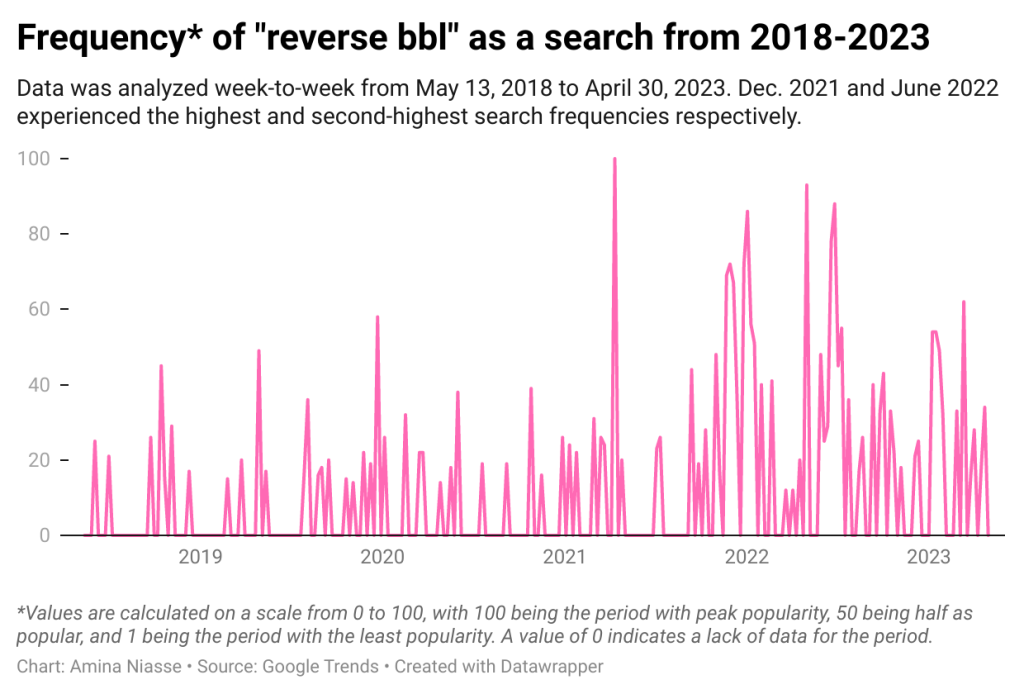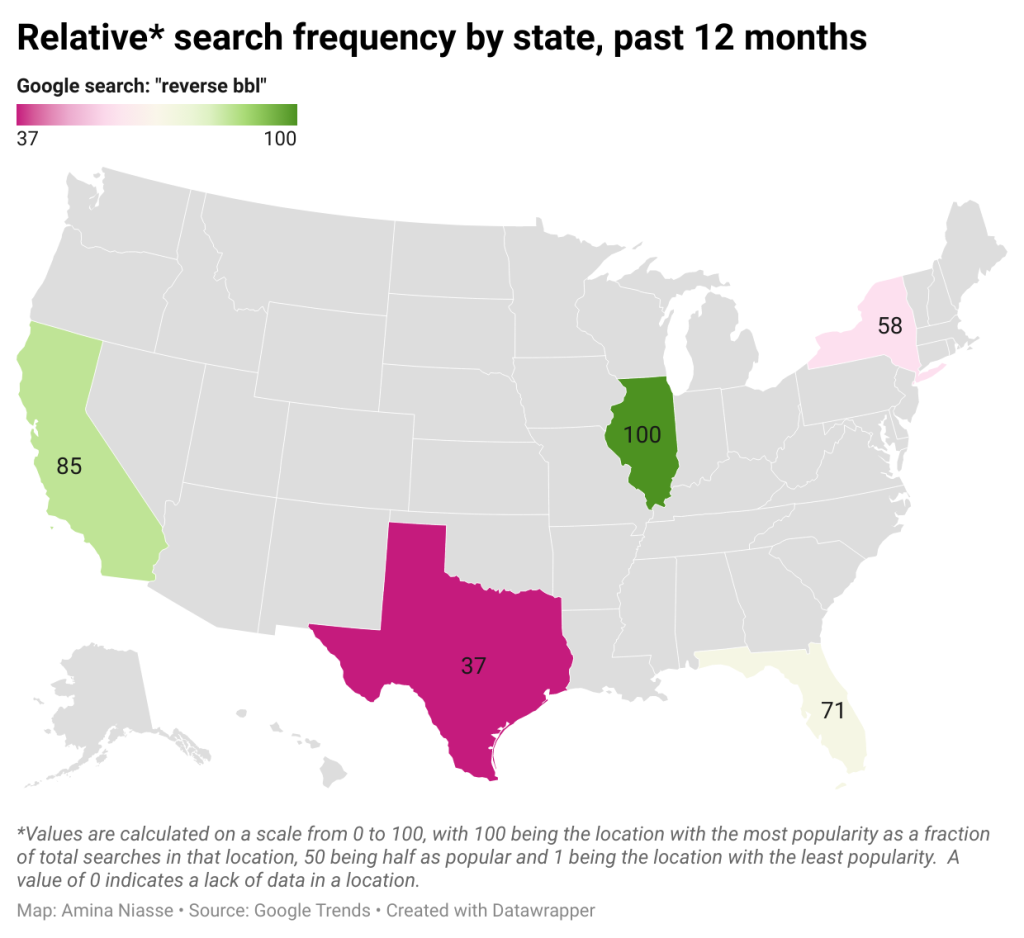The once rapidly growing trend of gluteal fat augmentations is now reversing in 2023 as more women pursue weight loss goals.
Ardashia Johnson woke up on a hospital table in Tijuana, Mexico to the sound of her nurse praying profusely in Spanish. Johnson was only awake for moments, during which a cacophony of Padre Nuestros and Santa Marías flooded her room. Next to her, a female medical staff screamed in sorrow. Johnson’s panicked inquiries for an explanation fell on deaf ears due to a language barrier — none of the staff spoke fluent English.
When a nurse who spoke English finally entered the room, she informed Johnson that another patient suffered an aneurysm while under anesthesia.
The woman across the hall, who was undergoing a buttock augmentation with fat grafting — better known as a Brazilian butt lift — died suddenly. Johnson’s fear upon hearing the news was amplified by the striking pangs of pain she began to feel as her medication wore off. Staff at the Bella Bodiez plastic surgery clinic, where Johnson had flown for a tummy tuck procedure, administered another round of anesthesia and soon she was back under. She woke up stunned by her results, which she describes were “perfect.” Still, that butt lift gone wrong stuck with her.
Despite what she’d witnessed, Johnson’s aftercare was nothing short of amazing. After a traumatizing night, her medical staff reassured her. Her doctor spent time playing through the surgery’s video footage with her, and she was provided an extra day of post-operative care.
“I couldn’t walk. They literally gave me a shower. They brushed my teeth … they did everything,” said Johnson. “They fed me as well. Then they had a driver for me, and the driver put me in a car and took me [to my hotel].“
Even though she was informed of another woman’s death in the same plastic surgery clinic, the quality of the clinic’s care reinforced the Atlanta resident’s belief that plastic surgery in Mexico was worth it and still a better deal than in the United States.
After her successful tummy tuck, the mother of three decided to use some of her time quarantining during the COVID-19 pandemic to identify her new body goals. As she looked in the mirror at home, she resolved to increase the size of her buttocks. In 2020, she booked her own butt lift at the same establishment that tucked her tummy a year earlier.
Johnson wasn’t alone in wanting to change her backside. Between 2015 and 2019, Brazilian butt lift procedures grew by 90% globally, according to The Aesthetic Society, a medical education organization comprised of plastic surgeons. The procedure, often abbreviated to a BBL, involves the liposuction of fat from other areas of the body and their injection into the buttocks. A 41% increase in the surgery occurred between 2017 and 2022, largely driven by pent-up demand during the COVID-19 pandemic.
Now post-pandemic, what was once a rapidly growing procedure may be getting the boot as more women pursue rising weight loss goals in an attempt to reduce or entirely reverse their results. The reasons are multiple and coincide with the market dominance of revolutionary weight loss drugs such as Ozempic.
“Girls will ask me if they should do this procedure, and I honestly tell them ‘Avoid the BBL as much as possible’,” said Johnson. Three years after returning to Bella Bodiez for her butt lift, Johnson is now in the process of having hers reduced due to weight complications.
Before her procedure, post-operative weight maintenance was the least of Johnson’s worries. Johnson, who became very aware of the BBL’s mortality rate after her initial visit to the clinic, spent much of her time researching the safety and surgical methods of the procedure.
For every 6,000 women who underwent a BBL in 2017, one to two died according to The Aesthetic Society. The number of deaths is higher overseas due to a higher rate of injection into the gluteus maximus muscle abroad. The practice is banned in the United States after the American Board of Plastic Surgery, the certifying body for plastic surgeons in the United States, determined injecting fat directly into the muscle causes a higher rate of fat embolisms. These embolisms are a disruption to one’s blood supply that can be fatal.
“We used to inject fat into the muscle. The reason was twofold,” said Dr. Matthew Nykiel of Butts By Design, a plastic surgery facility based in Newport Beach. “It has more blood supply, so more fat would live if you injected it. Number two, it would [directly] increase the size of your glutes.”

Ardashia Johnson (Photo courtesy of Johnson)

Egypt Rodriguez, Founder of BBL Basics (Photo courtesy of Rodriguez)

Jim Steyer, Founder of Common Sense Media (Photo courtesy of Steyer)
Because of these aesthetic benefits, thousands of women are undaunted by the risks of unregulated fat transfers. In an era where dramatic behinds are an ideal, patients often aim to preserve as much of their fat graft as possible. This ambition is what pushes many consumers toward international plastic surgeons in countries such as Mexico or the Dominican Republic where doctors are able to inject more fat into the buttocks while pumping it directly into the gluteal muscle, according to Nykiel. One of those people told Johnson about the treatment.
“This girl I used to go to the gym with, she went to Mexico four years prior to me. I’ve been stalking this company for years. I’ve been looking into them, seeing what’s going on, checking comments and just doing my research on them,” said Johnson. “But sadly, you can’t do too much research.”
A Booming Industry in Mexico
Bella Bodiez, like many clinics overseas, did not assign a doctor to Johnson until she arrived on-site. It’s a practice that she says can put women at the whim of a doctor’s surgical style and preferences, which could result in a butt they don’t want. When Johnson ventured back to Mexico for her BBL surgery, she wanted her doctor to create a subtle (“slim-thick”) shape.
“I told him ‘I don’t want to look like Nicki Minaj.’ I was looking for the Iggy Azalea look because she has a nice butt but not too big,” said Johnson.
Her second surgery went smoothly, complete with quality aftercare and a dutiful medical staff. While her butt was a bit bigger than she expected, Johnson’s body was sculpted into a perfect hourglass shape, just as she desired.
“A lot of bodies in the U.S. are kind of boxy, that’s why you go to Mexico or Colombia because they have no limits on the amount of fact they [inject]. I had a really big butt afterwards,” said Johnson. “But then I started to hate it.”
Her decision to go through with the procedure is one Johnson has come to regret, due to the upkeep. Like many women, she didn’t realize she’d have to diet and work to maintain her altered physique.
“If I could do this all over again, I probably would have avoided the BBL and just stuck with a tummy tuck because of the constant watching what you eat,” said Johnson “It’s constant with the BBL because you can eat something and you literally just blow up.”
Straight to the Booty

Weight-related maintenance is a responsibility many seeking plastic surgery are undereducated about, according to Dr. Nykiel. While diet and exercise are prime factors in a patient’s post-op results, social media promotion of the Brazilian butt lift often leaves these topics out.
“Influencers, models, people that even own gyms, fitness gurus … they also got plastic surgery. And the reason they look the way they do is that they diet and they exercise every single day,” said Nykiel. “You’re going to have to diet and exercise afterward. Your weight can significantly impact your results.“
To make matters worse, many women whose bodies previously held weight in their midsection have difficulty gauging their weight fluctuations as their body shifts in composition, according to Nykiel. It’s an occurrence that leaves many patients confused about how their butts got so big.
“Most of us will judge our diet and exercise lifestyle by looking in the mirror and seeing how our clothes are fitting,” said Nykiel. “But after you’ve been liposuctioned and have a fat transfer, that changes your overall body dimensions and ratio.”
This is what Egypt Rodriguez experienced, after her second BBL. Rodriguez, who grew up relatively slim, never understood the importance of diet and exercise. The 28-year-old Miami resident pursued two operations of Brazilian butt lift surgery in South Florida after becoming insecure about her weight gain in her early 20s. Rodriguez says she loved her results initially, but she is now considering a reversal because of the high maintenance.
“The weight after a BBL is different. Now, every time I gain weight, it goes to my hips and my butt. It spreads across my lower body as opposed to all over,” said Rodriguez, who is now concerned that as she gets older and becomes a mother, her metabolism will slow down. “I wanted a dramatic look at the time … but I’ll have kids one day, and my hips may spread even more.”

The Return of “Heroin Chic“
There are other criticisms of BBLs. Vocal critics say the procedure contradicts changing beauty standards — ones that signal a return to the ‘heroin chic’ silhouette of the 90s.
“The video vixen girl is not in style anymore. To me, and to a lot of people, it looks cheap,” said Johnson. “You look like a stripper or a porn star. It’s not classy to walk around looking like that nowadays.”
But Rodriguez insists that the Brazilian butt lift will always have an audience of people aiming to cure themselves of body dysmorphia — a condition where a person is mentally preoccupied with an aspect of their physical appearance. She has since launched her business BBL Basics to provide women with post-operative support.
According to founder and CEO of Common Sense Media Jim Steyer, The rise of the skinny aesthetic this year is largely due to weight loss trends growing on social media platforms like TikTok, a platform that relies on short user-generated videos.
“A magazine, even an image on T.V. is a still photo,” said Steyer. “ But the problem with social media is it’s 24/7, and it’s a constant feedback loop which makes it that much more pervasive and impactful on young women.”
Most recently, the diabetes drug semaglutide, sold under the name Ozempic, went viral on TikTok as users raved about its weight loss benefits. The drug experienced a shortage in Dec. 2022 after the hashtag ‘#Ozempic’ reached over 600 million views.
Despite the weight loss drug craze, Johnson and Rodriguez hope to lessen the need for a reversal procedure by losing weight through natural diet and exercise before heading back to the operating table. Johnson is already seeing a decline in the volume of her buttocks.
“I thought about doing the mini [gastric] sleeve,” said Johnson who was supposed to go through with the procedure in November after receiving a consultation and a quote for $7,000. “But I said ‘Let me just try to do this on my own.’ And I’m glad I did.”
Rodriguez, who’s still on her reduction journey, hopes to lose weight through exercise within the next 12 months. She’s compiled a list of reversal doctors to contact in the meantime.
“Either the weight has to go or the ass has to go, but something has to change,” said Rodriguez. “I’m in the process of trying to get the weight off, and I’m giving myself a year. But if that doesn’t change, I’m just gonna go on the table and get it reduced.”

Hi, this is a comment.
To get started with moderating, editing, and deleting comments, please visit the Comments screen in the dashboard.
Commenter avatars come from Gravatar.